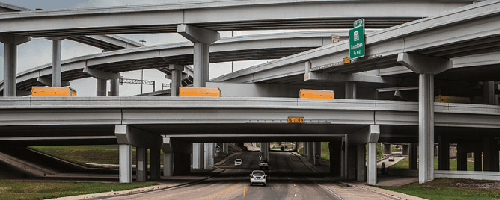
Construction, engineering and photography: "60 views of Ferrovial"
29 of July of 2013
Infrastructures constitute the framework of the modern life in which we conduct ourselves. The everyday actions of travelling on efficient, fast roads; strolling on properly cared-for streets and parks or enjoying the cultural attractions that cities offer in architectural spaces of great beauty are the challenges faced every day by architects, technicians, works site managers and operators. These challenges contribute to improving the quality of life of a society and its development.
The “60 Views of Ferrovial” exhibition is a tribute to a company recognised worldwide for its activity in the construction of complex works, the provision of urban services and the management of highways and airports. The show, which is hosted by CaixaForum Madrid, features images of the major engineering works undertaken and managed by Ferrovial all over the world during its 60-year history.
Its author, the Madrid painter and photographer José Manuel Ballester, winner of the 2010 National Photography Prize, describes the exhibition as an “honest, voluminous and ambitious” project that sums up in almost 60 photographs Ferrovial’s ability and versatility to meet society’s needs for infrastructures, mobility and services and to respond to the challenges of a society that is growing and evolving by leaps and bounds.
In the course of a year and 31,149 kilometres of travelling, José Manuel Ballester’s daring and experimental vision witnessed the momentousness of some of the most significant projects erected by Ferrovial all over the planet. In total, a schedule of 40 destinations, from the Hippodrome of La Zarzuela, in Madrid, to the expressways in North America (LBJ Express, etc.) and Chile; airports in Madrid and London (Heathrow); recycling plants, water treatment plants, nuclear stations and cultural spaces such as the Bilbao Guggenheim. “What distinguishes this work from others I have previously undertaken is the huge scale, the magnitude. I have encountered many surprises”, recognises Ballester. The photographer’s interest in showing man through his footprint is reflected in each one of the snapshots which comprise the show and which operate as “allegories of our very existence, which is in constant flux”. The images allow the spectator to reflect on the “intricate foundations that underpin the welfare society”, explains Ballester who, in this project, sought to ask himself how far human beings are capable of going. The photographer insists on the need to justify the function of infrastructures and of artists themselves: “My pledge is to demonstrate that art is useful. In nature, what is not useful disappears. It is natural selection”.
José Manuel Ballester’s work has followed the scheme of “Thinking, building and inhabiting”, adapted to the characteristics of a company such as Ferrovial, which covers the complete lifecycle of an infrastructure “from the process of the ideas, of thinking, of resolving problems to the process of executing and using, operating and maintaining”, explains the photographer. This was in fact one of the most surprising aspects for Ballester: “discovering that the company escaped the parameters I knew”. Given the “tsunami” of visual information, thousands of photographs had to be discarded: “I have had to do a great deal of refining, selecting and renouncing works that were greatly valid within my repertoire”.
Taken as a whole, the photographic collection seeks to establish “a dialogue between the world of art and that of infrastructures through an aesthetic, scientific and technological vision”. Added to this technology, which is what is on view, and to art, which is the value contributed by José Manuel, is the profound dialogue established between the space and the work, providing a double stimulus for the viewers. “On one hand they will find themselves up against the power of Ferrovial as a leading company in the infrastructures sector and, on the other, they will enjoy the painstaking technique of one of the country’s most important photographers”, explains Rafael Doctor, the show’s curator. With more than 20 years’ experience in the art world, Doctor has directed exhibitions in emblematic spaces such as the MUSAC of León or the Museo Nacional Centro de Arte Reina Sofía of Madrid.
This Ferrovial commission continues an important tradition in the history of photography in which prestigious artists are invited by institutions and companies to portray relevant infrastructures. In the 19th century Charles Clifford was able through his photographs to reflect something more than the construction of the Isabel II Canal. In the 20th, Luis Ramón Marín went beyond recording the development of the telephone network in Spain. Today, José Manuel Ballester captures Ferrovial’s work to reveal its transcendence and capacity to endure over time.
“For me art is like a flow of energy, it is like an orbital and we artists somehow enter these orbits that rotate around a single solar system”, explains José Manuel Ballester when analysing the influences on his work. “I am in favour of entering this visual continent and of discovering, with the risks this entails”. Ballester does not see himself as a pioneer, nor does he hold with the possibility of an individual creating from nothing. However, his particular interpretation of the architectural space and his ability to capture light, space and time have configured his artistic DNA, which accompanies him in all his works: urban landscapes, industrial prospects, etc. All of these characteristics, together with his outstanding contribution to the renewal of photographic techniques, were recognised with the National Photography Prize 2010 awarded by the Ministry of Culture.
José Manuel Ballester feels fortunate: “I have had the opportunity of seeing more things than any Ferrovial employee. I think there are few people with as much information on the company as I have”. Given such a “tsunami” of visual information, Ballester acknowledges that “the most painful part of the project was having to refine, select, renounce and sacrifice works that are highly valid within my repertoire”.
Ballester’s exhibition (“60 Views of Ferrovial”) will be on display from 12 June to 30 July at CaixaForum Madrid.





There are no comments yet